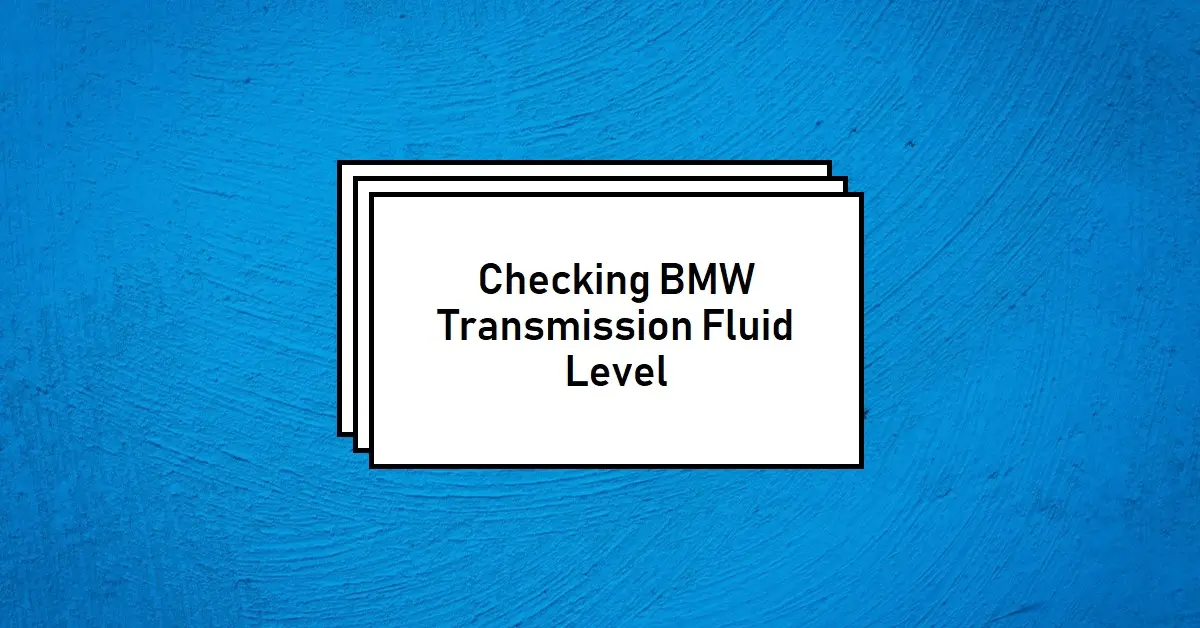How to Check BMW Transmission Fluid Level: A Guide
Keeping your BMW in top condition requires regular maintenance, and one of the most important tasks is checking the transmission fluid level. Transmission fluid plays a crucial role in lubricating and cooling the complex system that transfers power from the engine to the wheels. Neglecting to check and maintain proper fluid levels can lead to costly repairs or even transmission failure.
In this comprehensive guide, we’ll walk you through the step-by-step process of checking the transmission fluid level in your BMW, whether you have an automatic or manual transmission. We’ll also cover important details like when to check the fluid, what type of fluid to use, and signs that may indicate transmission issues. By the end, you’ll have the knowledge and confidence to perform this DIY maintenance task on your own.
Why is Transmission Fluid Important?
The transmission fluid in your BMW serves two primary functions:
- Lubrication: It lubricates the many moving parts within the transmission, reducing friction and wear.
- Cooling: It helps dissipate heat generated by the transmission during operation.
Low fluid levels or contaminated fluid can cause increased friction, excessive heat buildup, and premature wear on the transmission components. This can lead to slipping gears, rough shifting, and ultimately, transmission failure. Proper fluid levels and regular changes are essential for maintaining a smooth-shifting and long-lasting transmission.
When to Check BMW Transmission Fluid
It’s generally recommended to check your BMW’s transmission fluid level at least once a year or every 10,000 miles, whichever comes first. However, there are a few additional signs that may indicate it’s time for a fluid check:
- Difficulty shifting gears: If you notice your BMW hesitating or slipping when shifting gears, it could be a sign of low or contaminated transmission fluid.
- Unusual noises: Strange whining, grinding, or clunking noises coming from the transmission could also point to low fluid levels or internal damage.
- Leaks: If you spot reddish-pink fluid stains under your parked BMW, it may be transmission fluid leaking.
It’s always better to check the fluid level proactively rather than waiting for these warning signs.
What You Need to Check Transmission Fluid
Before you begin, make sure you have the following items on hand:
- A clean rag or paper towels
- A funnel (if you need to add fluid)
- The correct type of transmission fluid for your BMW (more on this later)
- Your BMW’s owner’s manual for reference
Having the right supplies and information readily available will make the process smoother and prevent any potential mess or mishaps.
How to Check Automatic Transmission Fluid in BMWs
If your BMW has an automatic transmission, follow these steps to check the fluid level:
Step 1: Locate the Dipstick
First, you’ll need to locate the transmission dipstick under the hood. In rear-wheel-drive BMWs, the dipstick is typically located toward the back of the engine compartment, behind the engine oil dipstick. In front-wheel-drive models, it’s usually on the driver’s side, near the front.
Consult your owner’s manual if you’re having trouble finding the dipstick, as its location can vary between models and years.
Step 2: Check Fluid Condition
Once you’ve found the dipstick, pull it out and examine the fluid on the end. The fluid should be pinkish-red and almost clear in color. If it appears dark, gritty, or has a burnt smell, it may be time for a fluid change.
Step 3: Check Fluid Level and Add Fluid if Needed
With the dipstick removed, use a clean rag or paper towel to wipe it off completely. Then, reinsert the dipstick fully and remove it again to check the fluid level.
The fluid should be between the “Full” and “Low” (or “Add”) marks on the dipstick. If the level is below the “Add” mark, you’ll need to top up the fluid.
To add fluid, use a funnel to pour in the correct type of transmission fluid (see the next section) slowly until it reaches the “Full” mark on the dipstick. Be careful not to overfill, as this can also cause issues.
Additional Tips for Automatic Transmissions
- Make sure the engine is warmed up and running when you check the fluid level. The fluid needs to be at operating temperature for an accurate reading.
- Set the transmission to “Park” or “Neutral” before checking or adding fluid.
- Use a funnel to avoid spills and make adding fluid easier.
- Don’t overfill the transmission, as this can cause foaming and other problems.
How to Check Manual Transmission Fluid in BMWs
The process for checking manual transmission fluid in BMWs is a bit more involved, as there is no dipstick to check the level. Instead, you’ll need to access the fill plug located underneath the vehicle.
Step 1: Raise the Car Securely
Begin by raising your BMW securely using either a hydraulic jack and jack stands or by driving the car onto ramps. Make sure the vehicle is stable and secure before proceeding.
Step 2: Locate the Fill Plug
With the car raised, locate the transmission fill plug, which is typically on the side of the transmission case. Consult your owner’s manual if you’re unsure of the exact location.
Step 3: Check Fluid Level and Condition
Using a wrench or socket, carefully remove the fill plug. The fluid should be level with the bottom of the fill hole. If it’s lower than that, you’ll need to top it up.
While the fill plug is removed, take a look at the fluid condition. It should be pinkish-red and clear, without any debris or discoloration.
If you need to add fluid, use a long-necked funnel to pour in the correct type of transmission fluid until it reaches the bottom of the fill hole.
Advice for Sealed Manual Transmissions
Some newer BMW models with manual transmissions have a sealed design without a fill plug. In these cases, it’s best to have a professional mechanic check and service the transmission fluid, as attempting to access it yourself could risk damaging the seals.
What Type of Transmission Fluid for BMWs?
Using the correct type of transmission fluid for your specific BMW model is crucial. The wrong fluid can cause damage or improper operation of the transmission.
Here’s a quick reference table for common BMW transmission fluid types:
| Transmission Type | Recommended Fluid |
|---|---|
| Automatic (up to 2003 models) | BMW Automatic Transmission Fluid |
| Automatic (2004+ models) | BMW Longlife-14 FE+ |
| Manual (non-M models) | BMW Manual Transmission Fluid |
| Manual (M models) | BMW M Transmission Fluid |
For the most accurate information, always refer to your BMW’s owner’s manual or consult with a certified BMW technician.
Signs of Transmission Fluid Issues
If you notice any of the following signs, it could indicate a problem with your transmission fluid or the transmission itself:
- Dark, discolored fluid: Transmission fluid should be pinkish-red and clear. Dark or opaque fluid may mean it’s contaminated or hasn’t been changed in a long time.
- Burnt smell: A burnt odor coming from the transmission area could signify overheated or burnt fluid.
- Metal shavings or debris: Any particles or gritty material in the fluid is a sign of internal wear and damage.
- Leaks: If you spot transmission fluid leaks under your BMW, it’s a clear sign of a leak that needs to be addressed.
- Erratic shifting: Rough, delayed, or slipping shifts can be caused by low or contaminated transmission fluid.
If you notice any of these issues, it’s best to have your BMW inspected by a qualified technician as soon as possible.
Transmission Fluid Change Intervals
While checking the fluid level is important, the transmission fluid will also need to be changed periodically. The recommended change interval can vary based on several factors:
- Manufacturer recommendations: BMW typically recommends changing the transmission fluid every 50,000 to 100,000 miles, depending on the model and type of transmission.
- Driving conditions: If you frequently tow heavy loads, drive in extreme temperatures, or engage in aggressive driving, you may need to change the fluid more often.
- Age of the vehicle: As your BMW ages, more frequent fluid changes may be necessary to maintain optimal transmission performance.
Consult your owner’s manual or speak with a BMW technician for the specific change interval recommended for your vehicle and driving conditions.
Importance of Routine Maintenance
Checking and changing your BMW’s transmission fluid is just one part of a comprehensive routine maintenance plan. Regular maintenance not only keeps your vehicle running smoothly but can also help prevent costly repairs down the road.
Here are a few examples of the potential costs associated with neglecting transmission maintenance:
- Transmission rebuild: Depending on the extent of the damage, a transmission rebuild can cost anywhere from $2,000 to $4,000 or more.
- Transmission replacement: For severe cases, you may need to replace the entire transmission, which can easily exceed $5,000 or more, including parts and labor.
- Towing and rental car expenses: If your transmission fails while you’re on the road, you’ll also need to factor in the cost of towing and a rental car while your BMW is being repaired.
By contrast, the cost of regular transmission fluid changes and maintenance is relatively inexpensive, typically ranging from $100 to $300, depending on the specific service.
Staying on top of routine maintenance, including checking and changing your transmission fluid as recommended, can save you a significant amount of money and hassle in the long run.
Conclusion
Checking your BMW’s transmission fluid level is a simple yet essential task that should be part of your regular maintenance routine. By following the step-by-step instructions outlined in this guide, you can easily check the fluid level yourself, whether you have an automatic or manual transmission.
Remember, transmission fluid plays a crucial role in lubricating and cooling your BMW’s transmission system. Neglecting to maintain proper fluid levels can lead to premature wear, rough shifting, and potentially costly repairs or replacements.
By taking a proactive approach and checking your transmission fluid level regularly, you can catch any issues early and keep your BMW running smoothly for years to come. Don’t wait for warning signs like difficulty shifting or leaks – make checking your transmission fluid a habit, just like checking your engine oil.
If you’re ever unsure about the process or have concerns about your transmission’s condition, don’t hesitate to consult a certified BMW technician. They have the expertise and specialized tools to diagnose and address any transmission-related issues properly.
Stay on top of your BMW’s maintenance, and you’ll be rewarded with a smooth-shifting, reliable vehicle that provides many miles of driving pleasure.







